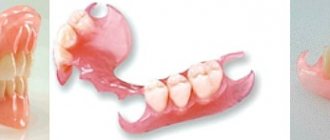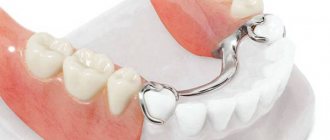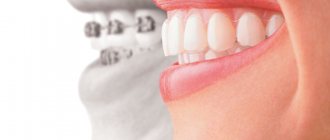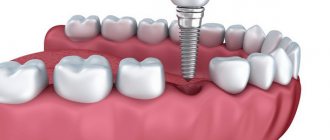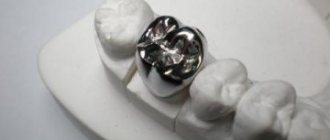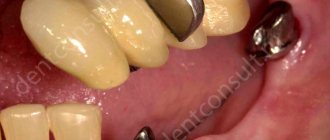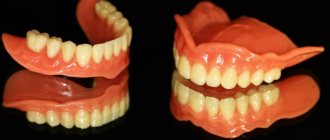This article will tell you what clasp dentures are. You will learn about the advantages and disadvantages of this type of prosthetics, the differences between clasp and plastic prostheses.
We will look at the reviews that clasp dentures receive. You will also learn in what cases you can use clasp dentures, the cost of which may vary for many reasons.
What is a clasp prosthesis?
Clasp dental prosthetics is a widely used treatment method in orthopedic dentistry. Designed to restore teeth in both the lower and upper jaws. The name itself comes from the German “bugel”, which means “arc”, that is, bugel - literally “having an arc”. The design of clasp dentures includes a metal or plastic arch, artificial teeth that are attached to a base that imitates gums, and fixing elements in the form of hooks, clasps or crowns.
What are the differences between a clasp prosthesis and a plastic one?
The presence of an iron frame can significantly reduce the volume and thickness of the plastic base on which artificial teeth are attached.
Look at fig. 1-2. The differences between a conventional prosthesis made of acrylic plastic and a clasp version are obvious. When prosthetizing anterior teeth, these differences are significant, since the clasp prosthesis has only a narrow iron arch, and the plastic one has a bulky bridge.
Fig. 1 Plastic prosthesis
The clasp is a narrow iron arch that gives the prosthesis strength and reliability. It can be used in cases where the production of bridge-like permanent structures is not possible. Therefore, a clasp denture can be confidently called an ideal candidate for a flexible nylon or removable plate denture.
Perceptions of patients and independent professionals about clasp dentures
Clasp prosthetics receives positive reviews, mainly for three reasons that are important for patients.
- Long service life. Manufacturers advise using a clasp prosthesis for up to 5 years. This is a fairly long period for removable prosthetics in general, especially if associated with plastic dentures, the service life of which is only 2.5 years.
This significant difference in service life is due to the fact that under clasp dentures, gum tissue and bone tissue atrophy even more slowly than under plastic dentures. The loss of tissue (atrophy) over time leads to the fact that their shape no longer corresponds to the shape of the prosthesis, which means that fixation worsens, pain occurs when wearing, and the like.
- Comfortable to wear. Comfortable installation of clasp dentures is achieved in almost all cases due to the reduction of the plastic base. As a result:
- instead of a bulky plastic base, there is only a narrow iron arch on the upper jaw, which does not cover the frontal part of the palate with the prosthetic base, on which the patient’s taste senses and his diction depend;
- the same narrow arch on the lower jaw gives freedom to the tongue, reducing diction problems and negating the risk of the entire denture falling out due to movements made by the tongue.
- Strength and reliability. The basis of the clasp prosthesis is a cast iron frame, therefore the possibility of breakage of the prosthesis is very small. In Fig. 3 you can see the frame and the plastic base and teeth fixed specifically to it. In the article about nylon dentures, you can see another option for dentures.
Stages of making a clasp prosthesis
Based on the principle of making the frame, the clasp prosthesis is divided into several types: soldered, solid-cast, milled, and based on laser sintering of nanoparticles of a special metal alloy powder. The last two methods are considered the most progressive and allow you to create a high-precision (up to 10 microns) and comfortable design.
Manufacturing takes place in 4 stages:
- first the dental technician creates a plaster model
- Based on the plaster model, a prototype of the prosthesis is cast and scanned
- using the scan, the frame of the clasp structure is modeled on a computer
- the prosthesis is ultimately sintered or milled.
The result exceeds all expectations - the prosthesis fits tightly to the gums and teeth, does not break and looks very aesthetically pleasing.
On clasps
Clasps are small hooks with which the prosthesis is secured to the supporting elements.
. These hooks are made exactly according to the shape of the supports, so a very tight fit and secure fastening are guaranteed.
The clasps are made from a metal alloy, so they are durable. With this type of fastening, a slightly different redistribution of loads occurs - the gums account for two-thirds, and only one part - for the supporting elements.
One of the features of clasps is that in many cases it is impossible to install them otherwise than with access to the visible side of the teeth. This leads to the fact that metal elements during close communication can be noticeable to the interlocutor.
The technology and design in this case are a little simpler, which affects the price. The approximate cost range for such prostheses ranges from 13 to 40 thousand rubles
.
What such structures are, see in the following video:
Indications for clasp prosthetics
The main indication for clasp dentures is the inability to install dentures on implants and the presence of at least several supporting teeth to which it could be secured. Partial structures are most often used both to replace several teeth with terminal defects and to restore a single tooth.
Whereas the clasp upper and lower denture completely reproduces the entire dentition. In addition, there is a splinting clasp prosthesis, which is used as a structure that restores and supports teeth. The prosthesis splints teeth affected by periodontitis or periodontal disease from the inside, replaces missing parts of the dentition and prevents the occurrence of adentia and prolongs the performance of the affected teeth.
Contraindications include:
- oral diseases in the acute stage
- increased tooth wear
- diseases leading to bone loss
- low or missing abutment teeth
- deep bite
- chronic neurological and mental diseases
- short frenulum of the tongue
- shallow floor of the mouth
- allergy to metal or other materials used in the design
Types of clasp dentures
Clasp dentures are also divided according to the method of their attachment to the supporting teeth. Unlike completely removable structures, which are fixed by suction to the gum or using special adhesives, fixation and installation of clasp dentures occurs using several types of fastening.
On clasps
Clasp dentures with clasps consist of metal hooks that clasp the abutment tooth in the neck area. The clasp clasp prosthesis is attached without grinding down the enamel, provided that the supporting teeth are not destroyed or affected by severe caries. However, this type is not aesthetic enough - the hooks are noticeable when you smile.
On locks or attachments
A locking clasp prosthesis consists of two parts, one of which is attached to the ground abutment teeth, and the second with the help of locks to the prosthesis itself. Unlike other types, a clasp denture with attachments is more immobile, so the load is distributed evenly on the supporting teeth and the alveolar mucosa.
Clasp prosthesis on telescopic crowns
When installing a clasp prosthesis on telescopic crowns, first fixed metal crowns are placed on the supporting teeth, and then ceramic crowns are placed in the prosthesis.
Description of the prosthesis
Doctors often use this design on the upper jaw, since it is the most convenient and relevant in this case. Effectively restores chewing function. The load is distributed, and the jaw acquires an aesthetic appearance.
A removable denture is installed on the upper jaw if several teeth are missing. Especially the rear ones, which are responsible for the chewing function. Less commonly used for complete restoration of the dentition. Also used in the following cases:
- palate defects (flatness);
- absence of tubercles in the upper jaw;
- in case of contraindications to the installation of other structures;
- wear of teeth.
They can also be installed in patients who have lost a tooth due to injury or mechanical impact.
Form of dentures
Clasp dentures for the upper jaw are different. The shape depends on the tooth defect and the indication for installing such a prosthesis. Each structure usually has a metal wire that connects it. It can be in the middle, front or back of the palate. The shape usually resembles a horseshoe. But this depends on the shape and structure of the patient’s jaw.
Such structures are most often installed when the back teeth are damaged. They are usually movable. A horseshoe-shaped arc is recommended for people with an increased gag reflex. Such arcs are divided into:
- Collarless . Does not touch healthy teeth, adheres to the palate.
- Vorotnikovaya . Adjacent to the gums, installed in deep bites.
A ring arch is indicated for installation in cases where a large number of teeth are missing in the upper row. In such cases, a ring-shaped structure is made.
There is also such a type as a transverse stripe. It is installed if a person suffers from a strong gag reflex. This strip is metal and fits tightly to the sky and secures the entire structure well.
Clasp dentures for the upper jaw depend on fixation. They must secure the artificial teeth well for comfortable use. For fastening, special locks or clasps are used (special fixation of the clasp).
Types of prostheses
The lock fixation is a rather complex design. Convenient for use on the upper jaw only. The main advantage of such a prosthesis is reliable fixation. He is not noticeable to others. The locks hold the entire structure very well. It does not slip during chewing and strangers cannot see it. The castle consists of 2 parts. One is installed during the frame casting process, on the edge. The second part is attached to crowns, which are located on top of living teeth.
During the installation of the prosthesis, these locks should snap into place easily. Should be easy to remove if necessary. It is important that the patient can do this himself without effort. Therefore, a high-quality clasp prosthesis can only be manufactured by a true professional.
The form of fastening is divided into spherical, rail, crossbar. The doctor determines which type of fastening to choose, taking into account the individuality of each patient. It is important to take into account dental defects and their stability. The load on the clasp prosthesis depends on this. Installation with fixation of locks can be with the installation of telescopic, double crowns.
A removable denture for the upper jaw is very practical and reliable in operation. If the upper part is completely missing teeth, the doctor installs several implants. For this purpose, beam fastenings are used. All designs are complex, but very effective and reliable. To give the structure strength, metal beams are used. Among other fastenings, he notes clasps, in other words they are called hooks.
This type of fixation is the simplest and most common. It is much easier to manufacture and install. They cost much less than other locks. The clasp prosthesis is reliable, but is not an aesthetic type. It is attached to natural teeth in such a way as if it covers the entire tooth.
If all teeth are lost, it is attached to implants. Clasp locks evenly distribute the load during chewing. The disadvantage is that it is visible when a person smiles. Therefore, some patients begin to feel embarrassed about such a prosthesis.
Taking into account the person’s wishes, the doctor usually tries to install such locks deeper so that outsiders cannot see him. Clasp clasps are made of stainless steel and various alloys. They are attached to the frame during the casting process. If the front teeth need to be restored, the doctor may use nylon hooks. They can be selected in a color that is closer to the natural shade of the teeth.
Nylon clasp quadrotti prosthesis
A product of the Italian company Quattro Ti, the quadrotti clasp prosthesis is very similar to a removable nylon prosthesis, with the only difference being that during its manufacture, nylon is mixed with hypoallergenic plastic. The resulting material has a number of advantages: it is more durable than nylon, and artificial teeth do not show through it. According to the manufacturers, this type of metal-free clasp prosthesis does not deform over time, does not cause discomfort when worn, and looks much more aesthetically pleasing than other prostheses. A soft prosthesis is attached to the teeth using plastic clasps, or saddles, covered on top with the same material as the base of the prosthesis. Saddles can be either pink or white, making them unnoticeable on the teeth. As for the disadvantages of the prosthesis, firstly, Quattro Ti is not strong enough, since no matter how strong the plastic is, it cannot be compared with metal. Secondly, a clasp prosthesis with nylon saddles requires special care using special means, which requires additional costs and cannot be repaired.
Caring for clasp dentures
Getting used to the clasp denture may take a couple of days. At first it will be somewhat uncomfortable for you to talk, so you will have to get rid of speech defects with the help of special exercises. Eating will also cause some difficulties. At first, to minimize pain, it is best to divide food into small portions and exclude very hard foods and sticky sweets from the diet. In order to quickly get used to the prosthesis, do not take it off at night.
Twice a day (morning, evening) it is necessary to remove the clasp prosthesis and clean it of plaque using the means recommended by the doctor, and also rinse it in a special antibacterial solution.
The clasp denture should be stored in a container, but not in water. Some types of structures, for example, soft quadrotti dentures, require special care, otherwise they fade and look unsightly on the teeth.
How to properly care for dentures
Clasp dentures are unpretentious in care, but careful treatment of the structure will help not only extend its service life, but also preserve the aesthetic characteristics of the product:
- After each meal, the denture should be washed in running water,
- To clean the structure, use a regular toothbrush and toothpaste without a whitening effect. When cleaning, do not use bleach, soda, citric acid or too hot water. It is recommended to repeat the procedure 2-3 times a day.
As for the adaptation period, certain problems often arise here. At the same time, the degree of discomfort during adaptation to the prosthesis largely depends not on the quality of the product, but on the individual characteristics of the patient’s body, including his psychological mood.
Watch the video of installing a clasp denture on the upper jaw:
- Iordanishvili, A.K. Clinical orthopedic dentistry, 2001.
Advantages and disadvantages
For comparison, let’s take the clasp’s “classmates” - fixed bridges and removable plate prostheses. Clasp orthopedic structures, of course, are superior to plate ones in strength, but, like bridges, they are a temporary way to restore the dentition. Despite all the efforts of manufacturers, the clasp is not able to stop the loss of bone tissue, the inevitable decrease of which soon leads to changes in facial features and disturbances in the functioning of the dental system and internal organs. The obvious disadvantages of a removable clasp also include an aesthetic defect when installing a clasp prosthesis, when metal hooks attached to the teeth are visible, and a slow adaptation time to the design. In addition, any denture puts pressure on the gums and causes discomfort when chewing and hypoxia - a condition in which the gums do not have enough nutrition, which causes bone tissue to atrophy even faster. As for the service life of clasp dentures, compared to dental implants, it is quite short and is no more than 10 years. Subject to proper care and timely correction once a year.
Patient reviews
Konstantin, Moscow. I used partially removable dental structures for 2 years until the need for prosthetics arose. Every person who wants to preserve the beauty of their teeth eventually faces the procedure. The doctor installed the bulge prosthesis for 3 weeks. There was no pain when installing the structures, since there was no need to grind the supporting units. I wear a denture and don’t notice that it’s in my mouth. I didn't have any adjustment period at all. The doctor allowed me to consume familiar foods (including those with dyes). I only excluded toffees and chewing candies from my diet.
Artemy, Samara. The dentist advised me to install a bulge denture on the lower jaw after I lost 1 molar. The doctor said that this particular design would be optimal in my case, since it would prevent premature loosening of neighboring elements. I have been wearing a plastic device for 3 years and can only note one drawback - the need to get used to the material. The adaptation period took 3-4 weeks. After that everything returned to normal.
Sergey, Tver. I did not appreciate the advantages of the design. The bulge denture did not hold well in the oral cavity and constantly moved when speaking. It was difficult to chew rough food and bite off large pieces of fruits and vegetables. I have been wearing the design for 1 month and hope that I will get used to it in the near future. I had to refuse implants due to the structural features of the jaw structures.
Tatyana, Orel. I wanted to restore my lower chewing teeth using bulge dentures. It took me about 1 month to get used to the new designs and even went to bed with them. The doctor dissuaded me from installing the consoles, citing the possible loosening of adjacent teeth. I noted the convenience of the system and the almost complete absence of discomfort when chewing food. The denture is simply removed and placed back in the mouth. Caring for it also does not cause much trouble.
How much does partial denture cost?
The average cost of clasp dentures in Moscow consists of the cost of the material, the work of the dental technician and the method of attachment to the supporting teeth. So, despite their popularity, the cost of nylon quadrotti dentures for one jaw is approximately the same as the price of clasp dentures - from 45,000 rubles and more. Clasp dentures with locks are somewhat more expensive - from 35,000 to 80,000 rubles. The most expensive of removable structures are considered to be dentures with telescopic crowns - their price ranges from 100,000 rubles to 200,000 rubles and more. As for clasp dentures on implants, their cost starts from 90,000 to 200,000 rubles and more, depending on the number of implants installed. If you decide to have a clasp prosthesis installed, then choose trusted clinics here.
High-quality clasp prosthetics is a worthy alternative to implantation, and in times of economic depression, clasp prosthetics is the most optimal option for restoring missing teeth.
Comparison of bar and bridge prostheses of the jaws
A bridge on implants is a permanent orthopedic structure. It is fixed with cement (fixed prosthesis) or with a screw method (conditionally removable).
The base necessarily contains a titanium arch, which connects the artificial roots, prevents them from loosening, and evenly distributes the chewing load on the structures and bone. The product is reliable and wear-resistant; it does not require special care.
With a one-stage implantation protocol, immediately after installation of the implants, an adaptive metal-acrylic dental bridge with acrylic (plastic) crowns is installed. This design is fixed during the healing of the implants. After 12 months, it is replaced with a permanent bridge with a titanium arch and more durable crowns - metal-ceramic, ceramic, zirconium.
Removable dentures on a titanium bar are inferior to permanent bridges on implants:
- They are often repaired because the devices are regularly removed for maintenance. If you remove/install the structure frequently and carelessly, the actions negatively affect the condition of the locking mechanism - the fasteners on the back of the product become loose and break. The service life of a removable product is 5-7 years, then a new one is made.
- In the case of removable products, the load during chewing is distributed only on the supporting implants. The areas of bone in which the implant is not implanted are little involved in the process - they dissolve over time. But atrophy progresses more slowly compared to traditional removable structures without titanium roots.
- An important condition for fixing implants under a bar prosthesis is sufficient bone volume. As an alternative to the beam design, single-phase dental implantation is recommended.
Expert of the article Voznyuk Vladimir Aleksandrovich Maxillofacial surgeon-implantologist of the highest category
Experience more than 30 years
Sign up for a consultation
three ROOTT specialists + diagnostics as a gift
All specialists Our specialists
The specialists of the ROOTT dental clinic install high-quality and reliable bar dentures on implants, turnkey, no additional payments. Our doctors professionally and responsibly perform operations of any complexity, which is due to their significant experience in the field of implantation and caring attitude towards patients.
Kustov Nikita Igorevich
orthopedic dentist
Anisimova (Pirkle) Kristina Vladimirovna
Dentist-therapist
